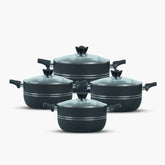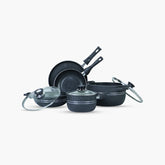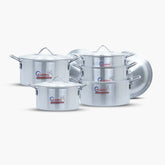Grill Pan Mastery: The Ultimate Guide for Cookware Enthusiasts
Grill pans have revolutionised indoor cooking, offering the charred flavours of outdoor grilling right from your stovetop. With their distinctive ridged surfaces, they not only sear meats and vegetables to perfection but also drain excess fats, promoting healthier meals. Whether you're a seasoned chef or a home cook, understanding the nuances of grill pans can elevate your culinary creations.
This comprehensive guide delves into the world of grill pans, exploring their types, benefits, usage tips, and maintenance, ensuring you harness their full potential in your kitchen.
1. Understanding Grill Pans
What is a Grill Pan?
A grill pan is a type of frying pan with raised ridges that mimic the grates of an outdoor grill. These ridges allow fats to drain away from the food, resulting in healthier cooking and those coveted grill marks.
History and Evolution of Grill Pans
Originating as a solution for indoor grilling, grill pans have evolved in design and material. From traditional cast iron to modern non-stick variants, they've become a staple in kitchens worldwide.
2. Benefits of Using Grill Pans
Healthier Cooking Options
The ridged design allows excess fats to drain away, reducing calorie intake and promoting healthier meals.
Achieving Perfect Grill Marks
Grill pans provide those distinctive sear lines, enhancing both the visual appeal and flavour of dishes.
Versatility in Cooking
Suitable for meats, vegetables, sandwiches, and even fruits, grill pans offer diverse cooking possibilities.
3. Types of Grill Pans
Cast Iron Grill Pans
Known for excellent heat retention and durability, cast iron pans are ideal for high-heat cooking. However, they require regular seasoning to maintain their non-stick properties.
Non-Stick Grill Pans
These pans offer easy food release and simple cleaning. For instance, the Klassic Nonstick Grill Pan combines convenience with performance, making it a popular choice among UK home cooks.

Enameled Grill Pans
Enameled pans provide the benefits of cast iron without the need for seasoning. They're also aesthetically pleasing, often available in various colours.
Stainless Steel Grill Pans
Offering a sleek appearance and resistance to rust, stainless steel pans heat up quickly but may not retain heat as effectively as cast iron.
4. Top Grill Pans in the UK Market
-
Lodge 11-Inch Cast Iron Square Grill Pan: Praised for its durability and heat retention.
-
Le Creuset Signature Square Skillet Grill: Known for its enameled surface and vibrant colours.
-
Staub Cast Iron Grill Pan: Offers a unique matte black enamel interior for better browning.
-
Klassic Nonstick Grill Pan 28cm: Combines non-stick convenience with a sturdy design, making it ideal for everyday use.
5. Choosing the Right Grill Pan
Material Considerations
Your choice depends on cooking habits. For instance, if you prefer low-maintenance cookware, non-stick pans like the Klassic Nonstick Grill Pan are ideal.
Size and Shape Factors
Consider your stovetop size and typical portion sizes. A 28cm pan offers ample space for family meals.
Compatibility with Heat Sources
Ensure the pan is suitable for your hob type, be it gas, electric, or induction.
6. Using Your Grill Pan Effectively
Preheating Techniques
Always preheat your grill pan to ensure even cooking and prominent grill marks.
Cooking Tips for Different Foods
-
Meats: Pat dry before placing on the pan to achieve a good sear.
-
Vegetables: Lightly coat with oil to prevent sticking.
Avoiding Common Mistakes
Avoid overcrowding the pan, as it can lead to steaming rather than grilling.
7. Maintenance and Care
Cleaning Tips for Different Materials
Non-stick pans should be cleaned with soft sponges to preserve the coating. For example, the Klassic Nonstick Grill Pan is dishwasher safe, simplifying cleanup.
Seasoning Cast Iron Grill Pans
Regularly apply a thin layer of oil and heat the pan to maintain its non-stick surface.
Storing Your Grill Pan Properly
Store in a dry place to prevent rust, especially for cast iron pans.
8. Grill Pan Recipes
Grilled Vegetables Medley
Toss bell peppers, courgettes, and aubergines in olive oil, season, and grill until tender.
Seared Steak with Herb Butter
Season steak, sear on high heat, and top with a mix of butter, garlic, and herbs.
Grilled Chicken Breast with Lemon Marinade
Marinate chicken in lemon juice, garlic, and herbs, then grill until cooked through.
9. Comparing Grill Pans with Other Cookware
Grill Pan vs. Frying Pan
While frying pans have flat surfaces, grill pans have ridges that allow fat to drain away, resulting in healthier cooking.
Grill Pan vs. Outdoor Grill
Grill pans offer the convenience of indoor cooking with similar searing capabilities, minus the smoky flavour of outdoor grills.
10. Safety Tips
Handling Hot Grill Pans
Always use oven mitts or heat-resistant gloves to prevent burns.
Using Appropriate Utensils
Opt for wooden or silicone utensils to avoid damaging non-stick surfaces.
11. Environmental Impact
Energy Efficiency of Grill Pans
Non-stick pans heat up quickly, reducing cooking time and energy consumption.
Sustainable Materials and Brands
Brands like Klassic focus on durable materials, ensuring longevity and reducing waste.
12. Budget-Friendly Options
Best Grill Pans Under £50
The Klassic Nonstick Grill Pan 28cm offers premium features at an affordable price point.
Value for Money Picks
Look for pans that combine durability, performance, and affordability.
13. Expert Reviews and Recommendations
Chef Insights on Grill Pan Usage
Professional chefs often recommend non-stick pans for their ease of use and quick cleanup.
Top Picks by Culinary Experts
The Klassic Nonstick Grill Pan is frequently highlighted for its performance and value.
14. User Testimonials
Home Cooks Share Their Experiences
Many users praise the Klassic Nonstick Grill Pan for its even heat distribution and ease of cleaning.
Favourite Recipes and Tips
Users recommend preheating the pan and lightly oiling food to achieve the best results.
Conclusion
Grill pans are an indispensable tool for those seeking the flavours of outdoor grilling without leaving their kitchen. Their design not only enhances the taste and appearance of food but also promotes healthier cooking by reducing fat content. Whether you're searing a steak, grilling vegetables, or crafting a panini, a grill pan offers versatility and convenience.
When selecting a grill pan, consider factors like material, size, and compatibility with your heat source. For instance, the Klassic Nonstick Grill Pan 28cm combines durability with ease of use, making it a valuable addition to any kitchen.
Proper maintenance ensures longevity, so always follow care instructions specific to your pan's material. With the right grill pan and techniques, you can elevate your cooking and enjoy delicious, grilled dishes year-round.
Quick Takeaways
-
Healthier Cooking: Grill pans allow excess fat to drain away, promoting healthier meals.
-
Versatility: Suitable for a variety of foods, including meats, vegetables, and sandwiches.
-
Indoor Grilling: Provides the charred flavour of outdoor grilling within the comfort of your kitchen.
-
Material Matters: Choosing the right material (cast iron, non-stick, etc.) affects cooking performance and maintenance.
-
Maintenance is Key: Proper cleaning and care extend the lifespan of your grill pan.
FAQs
1. Can I use a grill pan on an induction hob?
Yes, but ensure the grill pan is induction-compatible. Materials like cast iron and certain stainless steels work well with induction hobs.
2. How do I prevent food from sticking to my grill pan?
Preheat the pan thoroughly and lightly oil the food before placing it on the grill pan. For cast iron pans, proper seasoning is essential to maintain a non-stick surface.
3. Is it necessary to season a non-stick grill pan?
No, non-stick grill pans come with a coating that prevents sticking. However, avoid using metal utensils to preserve the non-stick surface.
4. Can grill pans be used in the oven?
Many grill pans, especially cast iron ones, are oven-safe. Always check the manufacturer's guidelines to confirm oven compatibility.
5. How often should I clean my grill pan?
Clean your grill pan after each use to prevent residue buildup. For cast iron pans, avoid using soap; instead, use hot water and a brush, then dry thoroughly.








